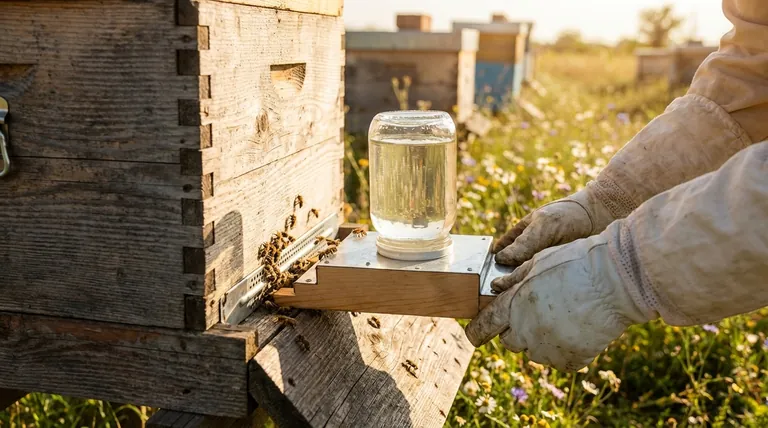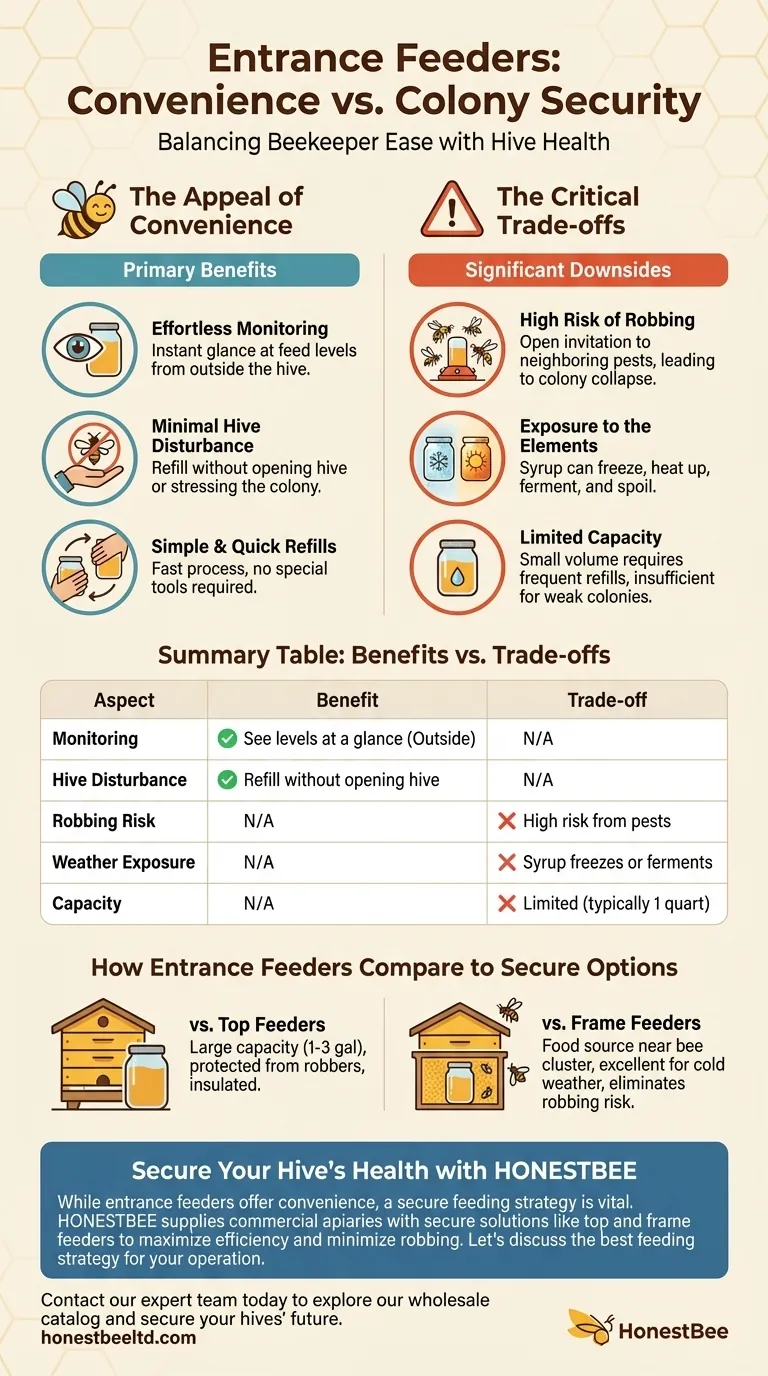At their core, entrance feeders offer beekeepers a highly convenient method for providing syrup. Their primary benefits are the ability to monitor feed levels at a glance from outside the hive and the ease of refilling the jar without opening the hive and disturbing the colony.
While entrance feeders provide unmatched convenience for the beekeeper, this ease of use comes at a significant cost to the colony's security. Their placement makes them highly susceptible to robbing by other bees and pests, a critical trade-off that must be carefully considered.

The Appeal of Convenience: Key Benefits
Entrance feeders, also known as Boardman feeders, consist of a small jar of syrup inverted into a tray that slides into the hive's main entrance. Their design prioritizes ease of use for the beekeeper.
Effortless Monitoring
Because the feed jar sits entirely outside the hive, you can instantly see how much syrup the bees have consumed. This allows for quick checks without any gear.
Minimal Hive Disturbance
Refilling an entrance feeder is the least invasive method available. You simply swap the empty jar for a full one without opening the hive, which avoids stressing the colony.
Simple and Quick Refills
The process of unscrewing a jar and replacing it is fast and requires no special tools. This makes it appealing for quick, small-scale feeding.
Understanding the Trade-offs: Critical Downsides
The convenience of entrance feeders comes with significant drawbacks that can jeopardize hive health. These issues often lead experienced beekeepers to choose other methods for primary feeding.
The High Risk of Robbing
Placing a food source at the hive's front door is an open invitation to neighboring honey bees, wasps, and ants. This can trigger a "robbing" frenzy, where invaders overwhelm the colony to steal its resources, often resulting in the death of the queen and the collapse of the hive.
While some designs try to limit access, the fundamental placement remains the primary vulnerability. This risk makes them a poor choice when other hives are nearby or during periods of nectar dearth.
Exposure to the Elements
The external jar is completely exposed to ambient weather. In cold temperatures, the syrup can freeze and become inaccessible. In direct sunlight, the syrup can heat up, ferment, and spoil.
Limited Capacity
Most entrance feeders use standard-sized jars, holding a quart of syrup at most. This small volume is often insufficient for building up a weak colony or for fall feeding, requiring very frequent refills.
How Entrance Feeders Compare to Other Options
To understand the role of an entrance feeder, it’s best to see it in context with the alternatives.
vs. Top Feeders
Top feeders sit on top of the brood boxes, directly under the main hive cover. They hold a large volume of syrup (often 1-3 gallons), are protected from robbers, and keep the feed insulated within the hive. This makes them ideal for bulk feeding in the fall or for beekeepers who can't visit their apiaries frequently.
vs. Frame Feeders
Frame feeders, or division board feeders, are plastic containers shaped like a frame and are placed inside the brood box. They keep the food source close to the bee cluster, making them excellent for feeding during cold or inclement weather when bees are reluctant to travel. They also completely eliminate the risk of robbing.
Choosing the Right Feeder for Your Goal
The best feeder is the one that aligns with your specific objective for the colony's health and security.
- If your primary focus is convenience for a quick, temporary boost in good weather: An entrance feeder can work, but only if you monitor it closely for any signs of robbing.
- If your primary focus is bulk feeding or preventing robbing: A top feeder is the superior choice due to its large capacity and secure, in-hive location.
- If your primary focus is supporting a weak colony or feeding during poor weather: A frame feeder ensures the bees can access food safely inside the cluster without exposure.
Ultimately, selecting the right feeding strategy is a critical step in supporting a healthy and productive colony.
Summary Table:
| Aspect | Benefit | Trade-off |
|---|---|---|
| Monitoring | See feed levels at a glance from outside | N/A |
| Hive Disturbance | Refill without opening the hive | N/A |
| Robbing Risk | N/A | High risk from bees, wasps, and ants |
| Weather Exposure | N/A | Syrup can freeze or ferment |
| Capacity | N/A | Limited (typically 1 quart) |
Secure Your Hive's Health with the Right Equipment
While entrance feeders offer convenience, a secure feeding strategy is vital for protecting your investment. HONESTBEE supplies commercial apiaries and beekeeping equipment distributors with the wholesale-focused solutions needed for healthy, productive colonies.
We provide a full range of secure feeding options, including top feeders and frame feeders, designed to minimize robbing and maximize efficiency.
Let's discuss the best feeding strategy for your operation.
Contact our expert team today to explore our wholesale catalog and secure your hives' future.
Visual Guide

Related Products
- Boardman Entrance Bee Feeder Durable Galvanized Steel and Wood Construction for Beekeeping
- Classic Boardman Entrance Bee Feeder Hive Front Feeding Solution
- HONESTBEE Entrance Bee Feeder Professional Hive Nutrition Solution for Beekeeping
- HONESTBEE Entrance Bee Feeder Efficient Hive Front Liquid Feeding Solution for Beekeeping
- Professional Hive Front Entrance Bee Feeder
People Also Ask
- Are entrance feeders good for bees? Prioritize Hive Health Over Convenience
- How does the entrance feeder method work? A Guide to Simple But Risky Hive Feeding
- What is an entrance feeder and how is it used? Avoid the Critical Risk of Robbing
- What are the different types of feeders available for beehives? A Guide to Entrance, Hive-Top, and Frame Feeders
- How does an entrance feeder work? A Guide to Its Simple Mechanics and Risks



















